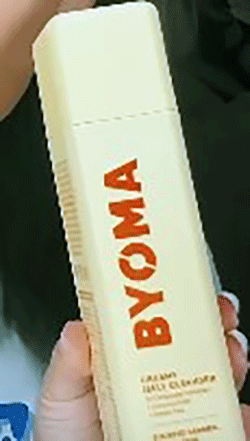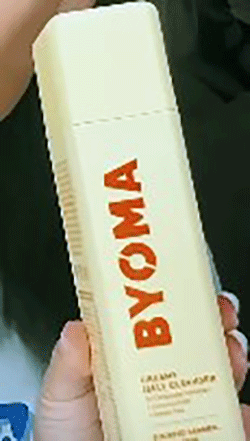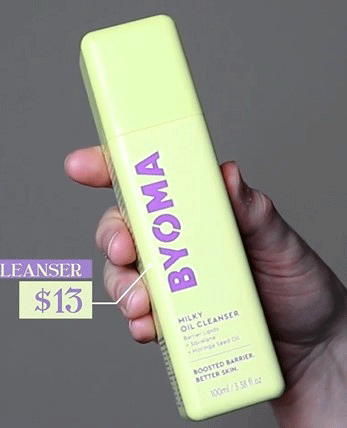If you’re on the hunt for a cleanser that’s gentle, hydrating, and effective at removing makeup and impurities, the Byoma Milky Oil Cleanser might just be your new skincare staple. As someone who’s tried countless cleansers, I can confidently say this one stands out for its unique oil-to-milk formula and barrier-boosting benefits. Whether you have dry, oily, or acne-prone skin, this cleanser is designed to nourish and balance your complexion. Let me walk you through my experience, the pros and cons, and tips to get the most out of it.
My Experience With The Byoma Milky Oil Cleanser
When I first tried the Byoma Milky Oil Cleanser, I was intrigued by its oil-to-milk transformation. Here’s what stood out to me during my time using it:

- Gentle Yet Effective: It effortlessly melted away my makeup, including stubborn mascara, without irritating my sensitive skin.
- Hydrating Formula: Unlike some cleansers that leave my skin feeling tight, this one left it soft, hydrated, and balanced.
- Pleasant Texture: The oil glides smoothly onto the skin and transforms into a milky consistency when mixed with water, making it easy to rinse off.
- No Residue: It didn’t leave any oily residue behind, which is a common issue with many oil-based cleansers.
- Subtle Scent: The light, natural scent is refreshing without being overpowering.
- Barrier Support: After a few weeks of use, I noticed my skin felt stronger and more resilient, thanks to the ceramides and skin-identical lipids.
- Versatility: It works well for both morning and evening routines, making it a versatile addition to my skincare regimen.
- Packaging: The sleek, minimalist bottle is both functional and aesthetically pleasing.
Pros Of The Byoma Milky Oil Cleanser
Let’s break down what makes this cleanser a standout choice:
- Barrier-Boosting Formula: Enriched with ceramides and skin-identical lipids, it strengthens your skin barrier while cleansing.
- Oil-to-Milk Transformation: The unique formula melts into a milky texture, making it easy to rinse off without leaving residue.
- Hydrating Ingredients: Moringa seed oil, olive fruit oil, and squalane work together to soothe and hydrate your skin.
- Gentle on Skin: It’s fragrance-free, alcohol-free, and non-comedogenic, making it suitable for all skin types, including sensitive skin.
- Effective Makeup Removal: It removes makeup, SPF, and impurities without stripping your skin of its natural oils.
- Dermatologist-Tested: Backed by science and dermatologist-approved, it’s a reliable choice for skincare enthusiasts.
- Vegan and Cruelty-Free: It’s ethically produced, so you can feel good about using it.
- Pleasant Experience: The lightweight texture and subtle scent make cleansing a luxurious experience.
- Brightening Effect: Regular use leaves your skin looking brighter and more radiant.
- Affordable Luxury: It delivers high-quality results without the high-end price tag.
Cons Of The Byoma Milky Oil Cleanser
Read More: My Thought on Arctic Ruby Oil Vs. Krill Oil
While I love this cleanser, it’s not without its drawbacks. Here’s what you should know:
- Not Fully Waterproof Makeup Proof: While it removes most makeup effectively, it may struggle with heavy, waterproof formulas.
- Subtle Scent: If you prefer fragrance-free products, the light essential oil-like scent might not be for you.
- Packaging: The bottle is sleek but doesn’t come with a pump, which can make dispensing the product a bit messy.
- Not Travel-Friendly: The liquid formula might not be ideal for travel, as it could leak in your bag.
- Limited Availability: It’s not as widely available as some other brands, so you may need to order it online.
- Price Point: While affordable, it’s slightly more expensive than some drugstore cleansers.
- Not Instant Results: The barrier-boosting benefits take time to show, so patience is key.
- May Not Suit Oily Skin: While it’s non-comedogenic, those with very oily skin might prefer a gel-based cleanser.
- Eye Sensitivity: Some users report mild stinging if the product gets into their eyes.
- Usage Rate: You might go through the bottle faster than expected if you use it twice daily.
How To Get The Most Out Of Your Byoma Milky Oil Cleanser

To maximize the benefits of this cleanser, here are my tips:
- Use on Dry Skin: Apply the cleanser to dry skin first to break down makeup and impurities effectively.
- Massage Gently: Use circular motions to massage the oil into your skin, ensuring it reaches every corner.
- Add Water Gradually: Slowly add water to transform the oil into a milky texture, then rinse thoroughly.
- Follow with a Second Cleanser: For a double-cleansing routine, follow up with a water-based cleanser to remove any remaining residue.
- Avoid Eye Area: Be cautious around the eyes to prevent stinging, especially if you wear heavy eye makeup.
- Store Properly: Keep the bottle upright to prevent leaks and store it in a cool, dry place.
- Use Consistently: Incorporate it into your daily routine to see the full barrier-boosting benefits.
- Pair with Hydrating Products: Follow up with a hydrating toner or serum to lock in moisture.
- Patch Test First: If you have sensitive skin, do a patch test to ensure it doesn’t cause irritation.
- Don’t Overuse: A little goes a long way, so use a small amount to avoid wasting the product.
Byoma Milky Oil Cleanser Vs. Other Brands
Let’s compare the Byoma Milky Oil Cleanser with some popular alternatives:
Byoma vs. DHC Deep Cleansin
- Texture: Byoma transforms into a milky texture, while DHC remains an oil, which some may find harder to rinse off.
- Hydration: Byoma is more hydrating, thanks to its ceramides and squalane, while DHC focuses on deep cleansing.
- Price: Byoma is more affordable, making it a better value for budget-conscious buyers.
- Scent: Byoma has a subtle, pleasant scent, while DHC is fragrance-free.
Byoma vs. Banila Co Clean It Zero
- Formula: Byoma is an oil-to-milk cleanser, while Banila Co is a balm that melts into an oil.
- Hydration: Both are hydrating, but Byoma’s barrier-boosting ingredients give it an edge for sensitive skin.
- Packaging: Banila Co comes in a jar, which some may find less hygienic than Byoma’s bottle.
- Versatility: Byoma is suitable for all skin types, while Banila Co may feel heavy for oily skin.
Byoma vs. The Ordinary Squalane Cleanser
- Texture: Byoma’s oil-to-milk formula feels more luxurious, while The Ordinary has a balm-like texture.
- Hydration: Both are hydrating, but Byoma’s additional oils and ceramides provide extra nourishment.
- Price: The Ordinary is slightly cheaper, but Byoma offers more advanced benefits.
- Ease of Use: Byoma rinses off more easily, making it a better choice for quick routines.
Maintenance Tips For Your Byoma Milky Oil Cleanser
Read More: My Thought on Arctic Ruby Oil Vs. Krill Oil
To ensure your cleanser stays effective and lasts as long as possible, here are some maintenance tips I’ve learned:
- Store Properly: Keep the bottle upright in a cool, dry place to prevent leaks and maintain the formula’s integrity.
- Avoid Contamination: Always use clean, dry hands to dispense the product to prevent bacteria from entering the bottle.
- Use a Pump (Optional): If you prefer a pump, consider transferring the cleanser to a pump bottle for easier and more hygienic use.
- Shake Gently: Before each use, give the bottle a gentle shake to ensure the ingredients are well-mixed.
- Keep the Cap Tight: Always secure the cap tightly after use to prevent spills and maintain freshness.
- Monitor Usage: A little goes a long way, so use a small amount to avoid running out too quickly.
- Pair with Complementary Products: Use it as part of a double-cleansing routine or follow up with hydrating toners and serums for optimal results.
- Travel Smart: If you’re traveling, transfer a small amount into a leak-proof container to avoid spills in your luggage.
- Check Expiry Date: Like all skincare products, it has a shelf life. Use it within the recommended timeframe for the best results.
- Patch Test New Products: If you’re introducing new skincare products, patch test them alongside the cleanser to ensure compatibility.

FREQUENTLY ASKED QUESTIONS (FAQ)
What is the Byoma milky oil cleanser used for?
The Byoma Milky Oil Cleanser is designed to remove makeup, SPF, and impurities while hydrating and strengthening your skin barrier. It’s perfect for daily use in both morning and evening routines.
Is Byoma milky oil cleanser good for acne-prone skin?
Yes! It’s non-comedogenic, meaning it won’t clog pores, and its barrier-boosting ingredients can help soothe and balance acne-prone skin. However, always patch test if you have sensitive or reactive skin.
Is the Byoma oil cleanser pore-clogging?
No, it’s specifically formulated to be non-comedogenic, so it won’t clog pores or leave an oily residue.
Conclusion
If you’re looking for a cleanser that’s gentle, hydrating, and effective at removing makeup and impurities, the Byoma Milky Oil Cleanser is an excellent choice. From its unique oil-to-milk formula and barrier-boosting benefits to its affordability and versatility, this cleanser has earned a permanent spot in my skincare routine. While it’s not perfect, its pros far outweigh the cons, making it a worthwhile investment for anyone seeking healthier, more balanced skin. Give it a try—you won’t be disappointed!
